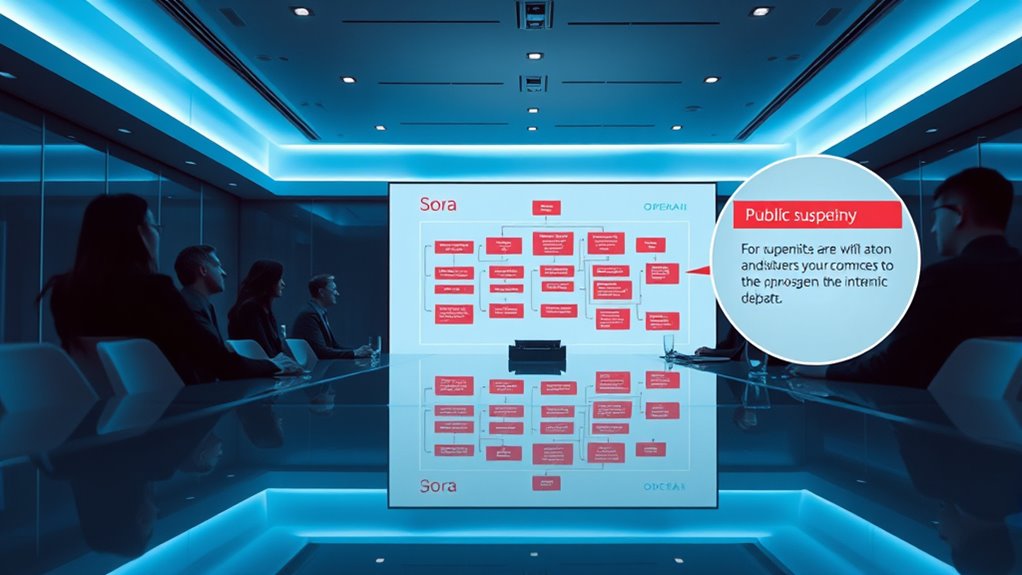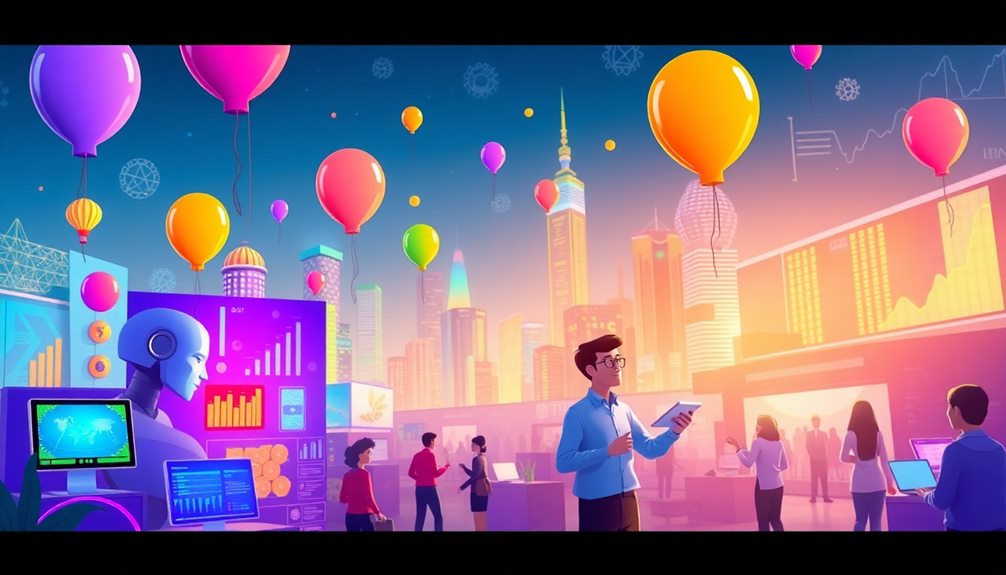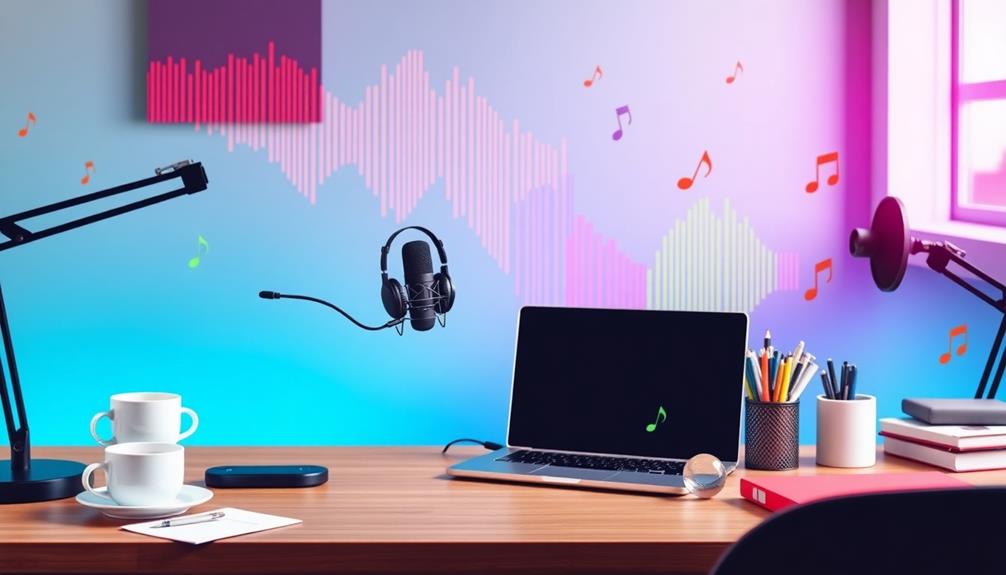OpenAI is re-evaluating its Sora framework due to rising public concerns over ethical risks and potential misuse. They’re actively reviewing safety protocols, moderation measures, and how the technology is deployed to prevent harm. This reconsideration aims to balance innovation with responsibility, ensuring the tool isn’t exploited for malicious purposes. If you want to understand how OpenAI is steering these challenges and what changes might come, there’s more to explore ahead.
Key Takeaways
- OpenAI is reevaluating Sora’s deployment protocols amid concerns over potential misuse and ethical risks.
- Enhanced safety measures and stricter moderation are being considered to prevent malicious applications.
- Public scrutiny prompts OpenAI to strengthen transparency and community engagement regarding Sora’s capabilities.
- The company is exploring limitations on features like realistic video synthesis and observation-driven embeddings.
- OpenAI aims to balance innovation with responsible use, possibly implementing tighter access controls and safety standards.

Could OpenAI’s Sora framework be poised for significant changes? As someone interested in AI advancements, you should know that Sora is a groundbreaking text-to-video model capable of generating detailed videos up to one minute long from simple prompts. It leverages a diffusion process, starting from noise and refining each frame step-by-step, much like how images are generated in earlier models. Its transformer architecture, similar to GPT models, allows for scalable, efficient performance, unifying video and image training by representing videos as collections of data patches—akin to GPT tokens. Building on prior research from DALL·E and GPT, Sora improves both fidelity and detail in text-to-video synthesis. Sora’s architecture enables it to generate high-fidelity videos that maintain visual consistency across frames, even during complex scenes. With the arrival of Sora 2, OpenAI has rolled out notable enhancements. You can expect sharper, more physically realistic videos with synchronized audio, making scenes more believable. The new version offers better control, enabling you to create both imaginative and grounded videos—ideal for storytelling or creative projects. It can incorporate real-world entities like people or objects into generated scenes through observation-driven embeddings, allowing for more personalized content. Available via sora.com, an iOS app, and soon an API, Sora 2 aims to make advanced video generation accessible to a broader audience.
The model’s new functionalities support convincing short-form vertical videos with synchronized dialogue and ambient sounds. It emphasizes realistic physics behaviors, reducing the bizarre object teleportations or distortions common in earlier versions. You can now generate multi-shot videos that maintain consistency in world state, giving you cinematic control over scenes. Sora 2 can animate still images and fill in missing frames, extending existing videos seamlessly. It also supports various visual styles, from realistic to anime, giving you creative flexibility. These generative models are a significant step forward in content creation, offering new opportunities for artists and developers alike.
OpenAI has introduced features like the “Cameo” tool, letting you insert observed individuals or objects into scenes realistically. You can embed real human appearances or voices using short clips, allowing for personalized, multimedia storytelling. However, these innovations raise safety and ethical concerns. OpenAI has responded by limiting access, implementing strict moderation, and conducting internal safety assessments to prevent misuse. As a result, public scrutiny and ethical considerations continue to shape the future of the Sora framework, prompting ongoing reevaluation of its deployment and safety protocols.
Frequently Asked Questions
Will Openai Abandon the Sora Framework Entirely?
No, OpenAI isn’t planning to abandon the Sora framework. They’re actively developing and improving it, despite public concerns and technical challenges. You’ll notice ongoing updates, safety measures, and phased rollouts aimed at addressing issues like privacy and copyright. Instead of quitting, OpenAI is focusing on making Sora safer, more reliable, and adaptable, showing their commitment to advancing AI content creation without abandoning their vision.
How Will Public Feedback Influence the Framework’s Future?
Your voice shapes Sora’s future like a guiding light through fog, steering improvements in accuracy, safety, and control. You’ll see faster, more reliable features as OpenAI listens to your feedback about realism and user access. Your insights push for stronger copyright protections and transparent content handling, making the platform safer and fairer. Together, your input fuels innovation, ensuring Sora evolves to meet your needs with responsible, cutting-edge technology.
Are There Alternative Frameworks Being Considered?
Yes, you’re likely exploring alternatives like Runway, Synthesia, or Pika Labs, which offer diverse features and pricing options. These platforms provide capabilities like text-to-video, rapid social media content creation, and natural-language editing, making them appealing if Sora’s limitations concern you. You might also consider open-source options like Mochi-1 for customization or platforms with broader geographic access, especially if regulatory constraints affect your usage.
What Specific Concerns Prompted the Reconsideration?
You’re concerned about privacy violations and the misuse of realistic videos, especially without consent. The risks of deepfake content, misinformation, and harmful material targeting minors are pressing. You also worry about safety challenges in moderating harmful content and the model’s reliability issues, like inconsistent physics or audio sync problems. These issues, combined with legal and ethical uncertainties, prompted OpenAI to reconsider the framework to better address societal harms and ensure responsible deployment.
How Will This Affect Ongoing Projects Using Sora?
Your ongoing projects using Sora might face delays and limitations. Since the public API isn’t fully available yet, you’ll need to monitor OpenAI’s announcements for updates. Restricted initial access, regional limits, and phased rollouts could slow down integration and scaling. You’ll also need to adapt workflows for stricter safety and moderation policies, and prepare for potential platform updates that might require retraining or process adjustments as the ecosystem evolves.
Conclusion
As you watch OpenAI reconsider its Sora framework amid public scrutiny, remember that even the brightest stars can cast shadows. Like Icarus soaring too high, innovation demands humility and reflection. Your role in this evolving landscape is essential—question, challenge, and stay vigilant. Only then can progress truly soar, guided not just by ambition but by the wisdom to heed its own shadows, ensuring a future where technology uplifts rather than blinds.










